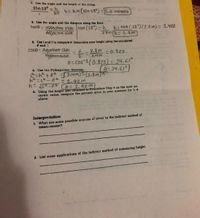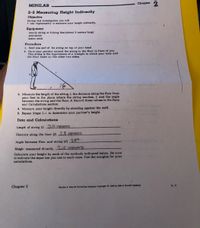Question
please help with number 5 and the interpretation questions 1 and 2

Transcribed Image Text:1. Use the angle and the length of the string.
Sin28°
hh=3.4(sin 28°) =2.6 meters
3.4
2. Use the angle and the distance along the floor.
tane = oppasTte side tan (28°) - h
Adjacent side
h= tan ( 28°)(2.8 m)= 1.488
2.8m h=1.5m
3. Use l and / to oompute O. Determine your height using the calculated
e and .
Cose - Adjacent side
Hypotenuse
2.8 m
3.4m
to
= 0.823
%3D
0= Cos-1(0.823) = 34.61°
0=34.61
%3D
4. Use the Pythagorean theorem.
-h?+e? =(3:4m)=(2.8m)
31.92m
5. Using the height you obtained in Procedure Step 4 as the most ac-
curate value, compute the percent error in your answers for 1-4
above.
1. What are some possible sources of error in the indirect method of
measu rement?
Interpretation
2. List some applications of the indirect method of measuring helght.

Transcribed Image Text:Chapter 2
MINILAB
%3
2-2 Measuring Height Indirectly
Objective
During this investige tion you will
• use trigonometry to measure your height indirectly.
Equipment
sturdy string or fishing line (about 3 meters long)
protractor
meter stick
Procedure
1. Hold one end of he string on top of your head.
2. Have your partnor extend the string to the floor in front of you.
This string is the hypotenuse of a triangle in whích your body and
the floor make uj) the other two sides.
3. Measure the length of the string, I, the distance along the floor from
your feet to the place where the string touches, f, and the angle
between the string and the floor, 6, Record these values in the Data
and Calculations section.
4. Measure your height directly by standing against the wall.
5. Repeat Steps 1-4 to determine your partner's height.
Data and Calculations
Length of string (1) 3,4 meders
Distance along the floor () -2.8 meters.
Angle between floor and string (0) 28°
Height measured di rectly 1.6 meters
Calculate your height by each of the methods indicated below. Be sure
to indicate the equa Jon you use in each case. Use the margins for your
calculations.
2-7
Chapler 2
Charlon K. Merrill Publialing Compuny Copyright © 1066 by Ball & Howell Company.
Expert Solution
This question has been solved!
Explore an expertly crafted, step-by-step solution for a thorough understanding of key concepts.
This is a popular solution
Trending nowThis is a popular solution!
Step by stepSolved in 2 steps

Knowledge Booster
Similar questions
- Problem 1: Convert to Sl and write in scientific notation: a) 55 mph (miles per hour) to m/s b) 6.0 gallons to liters c) 1.282 light-seconds to m d) 1 acre to m²arrow_forwardSuppose your speedometer has an uncertainty of 4.5 km/h at a speed of 92 km/h. If the speedometer has the same percent uncertainty when it reads 55 km/h, what is the highest speed, in kilometers per hour, that you might be going? If the speedometer has the same percent uncertainty when it reads 55 km/h, what is the lowest speed, in kilometers per hour, that you might be going?arrow_forwardThis solution does not make sense as it does not look lik you used the correct formula for range.arrow_forward
- The answer seems incorrect. Maybe it's because of multiplying wrong angles while calculating the x and y components. Please recheck and correct the answer.arrow_forwardCould you possibly include a picture of the written solution, the transcription gets a bit confusing! Thank you :)arrow_forwardUsing your values for 7, calculate the average period Ibar (I) and its standard error. How does the error on the average period /bar (T) compares to the errors on the periods, I? What can you do to reduce the uncertainty on /bar (T)? What can you do to reduce the uncertainty on 7 ? Peried Trial T AT 4 141 $ 10.69 +α-0.5 2 10.60 + or -0.5 2 10.40 +α-0.5 10.43 +α-0.5 S 10.37 + or -0.5 Using your values for T, calculate the average period 7 and its standard error How does the error on the garage period compares to the errors on the periods, 7? What can you do to reduce the uncertainty on 7? What can you do to reduce the uncertainty on T7arrow_forward
arrow_back_ios
arrow_forward_ios